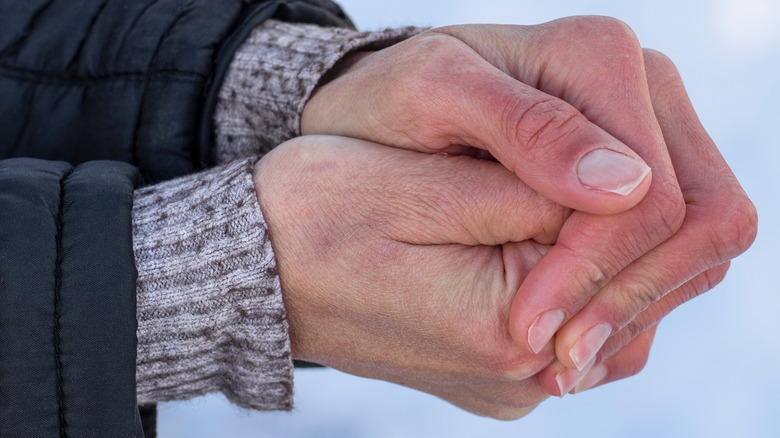How Long Does It Take For You To Get Frostbite?
Exposure to cold weather conditions can do far more than just make our teeth chatter or skin shiver. Rather, in cases of frostbite, the tissues underneath our skin (as well as the skin itself) can freeze, according to the Mayo Clinic. In more severe instances, frostbite can leave us susceptible to permanent skin damage.
A 2009 study published in the Scandinavian Journal of Work, Environment & Health found that skilled agricultural and fishery workers, plant and machine operators, and assemblers and technicians were among those who reported higher rates of frostbite in their line of work. However, cases of frostbite weren't only found to be correlated with work conditions. Rather, a connection between frostbite and leisure time was also observed. Whether for work or play, spending extended periods of time outside in the wind and cold — especially without proper clothing protection — can greatly increase one's chances for frostbite. In such instances, how much time can pass before signs of frostbite begin to set in?
Timing of frostbite can vary by temperature
Frostbite tends to emerge in specific areas of the body. Researchers from a 1995 study published in The British Medical Journal examined risk factors that most contributed to cases of frostbite in over 900 young Finnish men. These patients had incurred cases of frostbite of the head and had been in need of medical care in comparison to more than 2,400 patients who had not suffered frostbite. They found that 58% of frostbite injuries were seen on the ears, while 22% were observed on the nose. The cheeks and other facial areas accounted for 20% of frostbite cases.
The study findings showed cases were often linked to risk factors such as not wearing a scarf or hat with earflaps, being sensitive to the cold, sweating of the hands and feet, and traveling in open automobiles in windy weather.
How quickly frostbite can set in depends on the outdoor temperature. For example, it takes roughly a half-hour for frostbite to occur at 0 degrees Fahrenheit or below (via HealthPartners). At -15 degrees Fahrenheit, however, it takes half that time, with frostbite potentially occurring in as little as 15 minutes, particularly when wind is present.
How to protect yourself from frostbite
To help reduce your chances of getting frostbite, it's important to practice prevention ahead of time before braving the cold. On particularly frigid, damp, or windy days, be sure to keep time spent outdoors short. When stepping foot outside, layer up with a wool hat that fits snuggly over the ears, as well as several layers of warm, roomy clothing that won't trap moisture, such as a windproof or waterproof jacket. Don't forget socks either. Pro tip: Make sure they're not too snug, as this can reduce blood flow. If there's enough room, consider slipping in some foot warmers too. Lastly, opt for mittens over gloves for optimal protection.
Alternatively, be sure to eat healthy meals and hydrate beforehand, as this can help the body stay warm. Refrain from drinking alcohol, as this accelerates the loss of heat. Additionally, while outside, keep the body actively moving and watch for warning signs of frostbite. Such signs include skin discoloration, as well as sensations of prickling or numbness. Should you notice these symptoms, move inside to a warm environment promptly.



